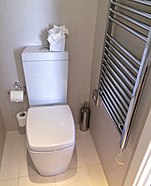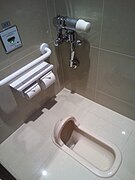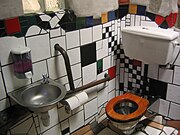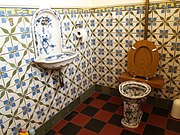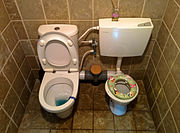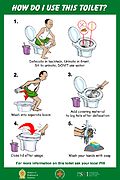Toilet
Atoilet[n 1]is a piece ofsanitaryhardware that collects humanurineandfeces,and sometimestoilet paper,usually for disposal.Flush toiletsuse water, whiledry or non-flush toiletsdo not. They can be designed for a sitting position popular in Europe and North America with atoilet seat,withadditional considerations for those with disabilities,or for a squatting posture more popular in Asia, known as asquat toilet.In urban areas, flush toilets are usually connected to asewer system;in isolated areas, to aseptic tank.The waste is known asblackwaterand the combined effluent, including other sources, issewage.Dry toilets areconnected to a pit,removable container,composting chamber,or other storage and treatment device, includingurine diversionwith aurine-diverting toilet.
The technology used for modern toilets varies. Toilets are commonly made ofceramic(porcelain), concrete, plastic, or wood. Newer toilet technologies includedual flushing,low flushing,toilet seat warming,self-cleaning,female urinalsandwaterless urinals.Japan is known forits toilet technology.Airplane toiletsare specially designed to operate in the air. The need to maintainanal hygienepost-defecationis universally recognized andtoilet paper(often held by atoilet roll holder), which may also be used to wipe thevulvaafter urination, is widely used (as well asbidets).
In private homes, depending on the region and style, the toilet may exist in the same bathroom as the sink,bathtub,and shower. Another option is to have one room for bodywashing(also called "bathroom" ) and a separate one for the toilet andhandwashingsink(toilet room).Public toilets(restrooms) consist of one or more toilets (and commonly singleurinalsortroughurinals) which are available for use by the general public. Products likeurinal blocksandtoilet blockshelp maintain the smell and cleanliness of toilets.Toilet seat coversare sometimes used.Portable toilets(frequentlychemical "porta johns") may be brought in for large and temporary gatherings.
Historically,sanitationhas been a concern from the earliest stages ofhuman settlements.However, many poor households indeveloping countriesuse very basic, and often unhygienic, toilets – and nearly one billion people have no access to a toilet at all; they mustopenly defecateand urinate.[1]These issues can lead to the spread of diseases transmitted via thefecal-oral route,or the transmission ofwaterborne diseasessuch ascholeraanddysentery.Therefore, the United NationsSustainable Development Goal 6wants to "achieve access to adequate and equitable sanitation andhygienefor all and end open defecation ".[2]
Overview
The number of different types of toilets used worldwide is large,[3][4]but can be grouped by:
- Having water (which seals in odor) or not (which usually relates to e.g.flush toiletversusdry toilet)
- Being used in a sitting or squatting position (sitting toilet versussquat toilet)
- Being located in the private household or in public (toilet roomversuspublic toilet)
Toilets can be designed to be used either in a sitting or in a squatting posture. Each type has its benefits. The "sitting toilet",however, is essential for those who are movement impaired. Sitting toilets are often referred to as" western-style toilets ".[5]Sitting toilets are more convenient than squat toilets forpeople with disabilitiesand the elderly.
People use different toilet types based on the country that they are in. Indeveloping countries,access to toilets is also related to people'ssocio-economic status.Poor people in low-income countries often have no toilets at all and resort toopen defecationinstead. This is part of thesanitationcrisis which international initiatives (such asWorld Toilet Day) draw attention to.[6]
With water
Flush toilet

A typicalflush toiletis a ceramic bowl (pan) connected on the "up" side to acistern(tank) that enables rapid filling with water, and on the "down" side to a drain pipe that removes the effluent. When a toilet is flushed, the sewage should flow into aseptic tankor into a system connected to asewage treatment plant.However, in manydeveloping countries,this treatment step does not take place.
The water in the toilet bowl is connected to a pipe shaped like an upside-down U. One side of the U channel is arranged as a siphon tube longer than the water in the bowl is high. The siphon tube connects to the drain. The bottom of the drain pipe limits the height of the water in the bowl before it flows down the drain. The water in the bowl acts as a barrier tosewer gasentering the building. Sewer gas escapes through a vent pipe attached to the sewer line.
The amount of water used by conventional flush toilets usually makes up a significant portion of personal daily water usage. However, modernlow flush toiletdesigns allow the use of much less water per flush.Dual flush toiletsallow the user to select between a flush for urine or feces, saving a significant amount of water over conventional units. One type of dual flush system allows the flush handle to be pushed up for one kind of flush and down for the other,[7]whereas another design is to have two buttons, one for urination and the other for defecation. In some places, users are encouraged not to flush after urination. Flushing toilets can be plumbed to usegreywater(water that was previously used for washing dishes, laundry, and bathing) rather thanpotable water(drinking water). Some modern toilets pressurize the water in the tank, which initiates flushing action with less water usage.
Another variant is the pour-flush toilet.[3]This type of flush toilet has no cistern but is flushed manually with a few liters of a small bucket. The flushing can use as little as 2–3 litres (0.44–0.66 imp gal; 0.53–0.79 US gal).[3]This type of toilet is common in many Asian countries. The toilet can be connected to one or two pits, in which case it is called a "pour flush pit latrine" or a "twin pit pour flush to pit latrine". It can also be connected to a septic tank.
Flush toilets on ships are typically flushed withseawater.
Twin pit designs

Twin pit latrinesuse two pits used alternatively, when one pit gets full over a few months or years.[8]The pits are of an adequate size to accommodate a volume of waste generated over one or two years. This allows the contents of the full pit enough time to transform into a partially sanitized,soil-like material that can be manually excavated.[9]There is a risk ofgroundwaterpollution when pits are located in areas with a high or variable water table, and/or fissures or cracks in the bedrock.[9]
Vacuum toilet

Avacuumtoilet is a flush toilet that is connected to avacuum sewer system,and removes waste by suction. They may use very little water (less than a quarter of a liter per flush)[10]or none,[11](as inwaterless urinals). Some flush with coloured disinfectant solution rather than with water.[10]They may be used to separateblackwaterandgreywater,and process them separately[12](for instance, the fairly dry blackwater can be used forbiogasproduction, or in acomposting toilet).
Passenger train toilets,aircraft lavatories,bus toilets, and ships with plumbing often use vacuum toilets. The lower water usage saves weight, and avoids water slopping out of the toilet bowl in motion.[13]Aboard vehicles, a portable collection chamber is used; if it is filled by positive pressure from an intermediate vacuum chamber, it need not be kept under vacuum.[14]
Floating toilet
A floating toilet is essentially a toilet on a platform built above or floating on the water. Instead of excreta going into the ground they are collected in a tank or barrel. To reduce the amount of excreta that needs to hauled to shore, many useurine diversion.The floating toilet was developed for residents without quick access to land or connection to a sewer systems.[15]It is also used in areas subjected to prolonged flooding.[16]The need for this type of toilet is high in areas likeCambodia.[17]
Without water
Pit latrine
Vault toilet
A vault toilet is a non-flush toilet with a sealed container (or vault) buried in the ground to receive the excreta, all of which is contained underground until it is removed by pumping. A vault toilet is distinguished from a pit latrine because the waste accumulates in the vault instead of seeping into the underlying soil.
Urine-diverting toilet
Portable toilet
Chemical toilet
Achemical toiletcollectshuman excretain a holding tank and uses chemicals to minimize odors. They do not require a connection to a water supply and are used in a variety of situations. These toilets are usually, but not always, self-contained and movable. A chemical toilet is structured around a relatively small tank, which requires frequent emptying. It is not connected to a hole in the ground (like apit latrine), nor to aseptic tank,nor is it plumbed into a municipal system leading to asewage treatment plant.[25]When the tank is emptied, the contents are usually pumped into asanitary seweror directly to a treatment plant.
Theportable toiletsused onconstruction sitesand at large gatherings such asmusic festivalsare well-known types of chemical toilets. As they are usually used for short periods and because of their high prices, they are mostly rented rather than bought, often including servicing and cleaning.[26]A simpler type of chemical toilet may be used intravel trailers(caravans) and on small boats.[27]Toilet fed to animals
Thepig toilet,which consists of a toilet linked to apigstyby a chute, is still in use to a limited extent.[28]It was common in rural China, and was known in Japan, Korea, and India. The "fish pond toilet" depends on the same principle, of livestock (oftencarp) eating human excreta directly.
"Flying toilet"
Squat toilets
-
AtTopkapı Palace,Turkey
-
Old-style squat toilet (Hong Kong)
-
In France
-
Porcelain squat toilet with water tank for flushing (Wuhan,China)
-
Japanese-style squat toilet with automatic sensor
Usage
Urination

There are cultural differences in socially accepted and preferred voiding positions for urination around the world: in the Middle East and Asia, the squatting position is more prevalent, while in the Western world the standing and sitting position are more common.[30]
Anal cleansing habits

In the Western world, the most common method of cleaning the anal area afterdefecationis bytoilet paperor sometimes by using abidet.In manyMuslim countries,the facilities are designed to enable people to followIslamic toilet etiquetteQaḍāʼ al-Ḥājah.[32]For example, abidet showermay be plumbed in. The left hand is used for cleansing, for which reason that hand is considered impolite or polluted in many Asian countries.[33]
Theuse of waterin manyChristian countriesis due in part to thebiblical toilet etiquettewhich encourages washing after all instances of defecation.[34]Thebidetis common in predominantlyCatholic countrieswhere water is considered essential foranal cleansing,[35][36]and in some traditionallyOrthodoxandLutherancountries such as Greece and Finland respectively, wherebidet showersare common.[37]
There are toilets on the market with seats having integrated spray mechanisms for anal and genital water sprays (see for exampleToilets in Japan). This can be useful for the elderly or people with disabilities.
Accessible toilets
Anaccessible toiletis designed to accommodate people withphysical disabilities,such as age related limited mobility or inability to walk due to impairments. Additional measures to add toilet accessibility are providing more space andgrab barsto ease transfer to and from thetoilet seat,including enough room for acaregiverif necessary.
Public toilets
Communication through toilets
Inprisons,inmates may utilize toilets and the associated plumbing to communicate messages and pass products.[38][39]The acoustic properties of communicating through the toilet bowl, known as toilet talk, potty talk,[40]toilet telephone[41]is influenced by flush patterns and bowl water volumes.[40]Prisoners may also send binary signals by ringing the sewage or water pipes.[42]Toilet talk enables communication for those in solitary confinement.[43]Toilets have been subject to wiretaps.[44]
Public health aspects
To this day, 1 billion people in developing countries have no toilets in their homes and are resorting toopen defecationinstead.[45]Therefore, it is one of the targets ofSustainable Development Goal 6to provide toilets (sanitation services) to everyone by 2030.[2][46]
Toilets are one important element of asanitationsystem, although other elements are also needed: transport, treatment, disposal, orreuse.[3]Diseases, includingCholera,which still affects some 3 million people each year, can be largely prevented when effectivesanitationand water treatment prevents fecal matter from contaminatingwaterways,groundwater,anddrinking watersupplies.
History
Ancient history

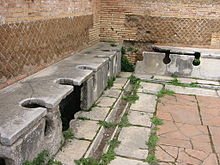
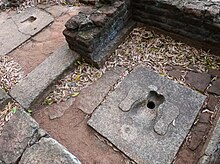

The fourth millennium BC would witness the invention of clay pipes, sewers, and toilets, inMesopotamia,with the city ofUruktoday exhibiting the earliest known internal pit toilet, fromc. 3200 BC.[47]The Neolithic village ofSkara Braecontains examples,c. 3000 BC,of internal small rooms over a communal drain, rather than pit.[48]TheIndus Valley civilisationin northwestern India and Pakistan was home to the world's first known urban sanitation systems. InMohenjo-Daro(c. 2800 BC), toilets were built into the outer walls of homes.[citation needed]These toilets had vertical chutes, via which waste was disposed of into cesspits or street drains.[49]In the Indus city ofLothal(c. 2350 BC), houses belonging to the upper class had private toilets connected to a covered sewer network[50]constructed of brickwork held together with a gypsum-based mortar that emptied either into the surrounding water bodies or alternatively intocesspits,the latter of which were regularly emptied and cleaned.[51]
Other very early toilets that used flowing water to remove the waste are found atSkara Braein Orkney, Scotland, which was occupied from about 3100 BC until 2500 BC. Some of the houses there have a drain running directly beneath them, and some of these had a cubicle over the drain. Around the 18th century BC, toilets started to appear inMinoan Crete,PharaonicEgypt,andancient Persia.
In 2012, archaeologists found what is believed to be Southeast Asia's earliest latrine during the excavation of a neolithic village in theRạch Núi archaeological site,southern Vietnam. The toilet, dating back 1500 BC, yielded important clues about early Southeast Asian society. More than 30coprolites,containing fish and shattered animal bones, provided information on the diet of humans and dogs, and on the types of parasites each had to contend with.[52][53][54]
InSri Lanka,the techniques of the construction of toilets and lavatories developed over several stages. A highly developed stage in this process is discernible in the constructions at theAbhayagiricomplex inAnuradhapurawhere toilets and baths dating back to 2nd century BC to 3rd century CE are known, later forms of toilets from 5th century CE to 13th century CE inPolonnaruwaandAnuradhapurahad elaborate decorative motifs carved around the toilets.[55][56][57]Several types of toilets were developed; these include lavatories with ring-well pits, underground terracotta pipes that lead to septic pits, urinary pits with large bottomless clay pots of decreasing size placed one above the other. These pots under urinals contained "sand, lime and charcoal" through which urine filtered down to the earth in a somewhat purified form.[55]
InRomancivilization,latrinesusing flowing water were sometimes part of publicbath houses.Roman latrines, like the ones pictured here, are commonly thought to have been used in the sitting position. The Roman toilets were probably elevated to raise them above open sewers which were periodically "flushed" with flowing water, rather than elevated for sitting. Romans andGreeksalso usedchamber pots,which they brought to meals and drinking sessions.[58]Johan J. Mattelaer said, "Pliniushas described how there were large receptacles in the streets of cities such asRomeandPompeiiinto which chamber pots of urine were emptied. The urine was then collected by fullers. "(Fullingwas a vital step intextile manufacture.)
TheHan dynastyin China two thousand years ago usedpig toilets.
Post-classical history
Garderobeswere toilets used in thePost-classical history,most commonly found in upper-class dwellings. Essentially, they were flat pieces of wood or stone spanning from one wall to the other, with one or more holes to sit on. These were above chutes or pipes that discharged outside the castle orManor house.[59]Garderobes would be placed in areas away from bedrooms because of the smell[60]and also near kitchens or fireplaces to keep their enclosures warm.[59]
-
Garderobe seat openings
-
View looking down into garderobe seat opening
-
Exterior view of garderobe atCampencastle
-
Toilet in Rosenborg Castle Copenhagen
The other main way of handling toilet needs was thechamber pot,a receptacle, usually of ceramic or metal, into which one would excrete waste. This method was used for hundreds of years; shapes, sizes, and decorative variations changed throughout the centuries.[61]Chamber pots were in common use in Europe from ancient times, even being taken to the Middle East by medieval pilgrims.[62]
Modern history



By the Early Modern era, chamber pots were frequently made of china or copper and could include elaborate decoration. They were emptied into the gutter of the street nearest to the home.
In pre-modern Denmark, people generallydefecated on farmlandor other places where thehuman wastecould be collected asfertilizer.[63]TheOld Norselanguage had several terms for referring toouthouses,includinggarðhús(yard house),náð-/náða-hús(house of rest), andannat hús(the other house). In general, toilets were functionally non-existent in rural Denmark until the 18th century.[63]
By the 16th century,cesspitsand cesspools were increasingly dug into the ground near houses in Europe as a means of collecting waste, as urban populations grew and street gutters became blocked with the larger volume of human waste. Rain was no longer sufficient to wash away waste from the gutters. A pipe connected the latrine to the cesspool, and sometimes a small amount of water washed waste through. Cesspools were cleaned out by tradesmen, known in English asgong farmers,who pumped out liquid waste, then shovelled out the solid waste and collected it during the night. This solid waste, euphemistically known asnightsoil,was sold as fertilizer for agricultural production (similarly to the closing-the-loop approach ofecological sanitation).
In the early 19th century, public officials and public hygiene experts studied and debated sanitation for several decades. The construction of an underground network of pipes to carry away solid and liquid waste was only begun in the mid 19th-century, gradually replacing the cesspool system, although cesspools were still in use in some parts of Paris into the 20th century.[64]Even London, at that time the world's largest city, did not require indoor toilets in its building codes until after theFirst World War.
Thewater closet,with its origins inTudortimes, started to assume its currently known form, with an overhead cistern, s-bends, soil pipes and valves around 1770. This was the work ofAlexander CummingandJoseph Bramah.Water closets only started to be moved from outside to inside of the home around 1850.[65]The integral water closet started to be built into middle-class homes in the 1860s and 1870s, firstly on the principal bedroom floor and in larger houses in the maids' accommodation, and by 1900 a further one in the hallway. A toilet would also be placed outside the back door of the kitchen for use by gardeners and other outside staff such as those working with the horses. The speed of introduction was varied, so that in 1906 the predominantly working-class town ofRochdalehad 750 water closets for a population of 10,000.[65]
The working-class home had transitioned from the rural cottage, to the urbanback-to-back terraceswith external rows of privies, to the through terraced houses of the 1880 with their sculleries and individual external WC. It was theTudor Walters Reportof 1918 that recommended that semi-skilled workers should be housed in suburban cottages with kitchens and internal WC. As recommended floor standards waxed and waned in the building standards and codes, the bathroom with a water closet and later the low-level suite became more prominent in the home.[66]
Before the introduction of indoor toilets, it was common to use thechamber potunder one's bed at night and then to dispose of its contents in the morning. During theVictorian era,British housemaids collected all of the household's chamber pots and carried them to a room known as the housemaids' cupboard. This room contained a "slop sink", made of wood with a lead lining to prevent chipping china chamber pots, for washing the "bedroom ware" or "chamber utensils". Once running water and flush toilets were plumbed into British houses, servants were sometimes given their own lavatory downstairs, separate from the family lavatory.[67]The practice of emptying one's own chamber pot, known asslopping out,continued in British prisons until as recently as 2014[68]and was still in use in 85 cells in Ireland in July 2017.[69]
With rare exceptions, chamber pots are no longer used. Modern related implements arebedpansandcommodes,used in hospitals and the homes of invalids.
Long-established sanitary wear manufacturers in the United Kingdom include Adamsez, founded inNewcastle-upon-Tynein 1880, by M.J. and S.H. Adams,[70]andTwyfords,founded inHanley,Stoke-on-Trentin 1849, by Thomas Twyford and his sonThomas William Twyford.[71]
Development of dry earth closets

Before the widespread adoption of theflush toilet,there were inventors, scientists, andpublic healthofficials who supported the use of "dry earth closets" – nowadays known either asdry toiletsorcomposting toilets.[72]
Development of flush toilets
Although a precursor to the flush toilet system which is widely used nowadays was designed in 1596 byJohn Harington,[citation needed]such systems did not come into widespread use until the late nineteenth century.[citation needed]With the onset of theindustrial revolutionand related advances in technology, the flush toilet began to emerge into its modern form. A crucial advance in plumbing, was theS-trap,invented by the Scottish mechanicAlexander Cummingsin 1775, and still in use today. This device uses the standing water to seal the outlet of the bowl, preventing the escape of foul air from the sewer. It was only in the mid-19th century, with growing levels of urbanisation and industrial prosperity, that the flush toilet became a widely used and marketed invention. This period coincided with the dramaticgrowth in the sewage system,especially in London, which made the flush toilet particularly attractive for health and sanitation reasons.[65]
Flush toilets were also known as "water closets", as opposed to the earth closets described above. WCs first appeared in Britain in the 1880s, and soon spread to Continental Europe. In America, the chain-pull indoor toilet was introduced in the homes of the wealthy and in hotels in the 1890s.William Elvis Sloaninvented theFlushometerin 1906, which used pressurized water directly from the supply line for faster recycle time between flushes.
High-tech toilet
"High-tech" toilets, which can be found in countries like Japan, include features such as automatic-flushing mechanisms;water jetsor "bottom washers"; blow dryers, or artificial flush sounds to mask noises. Others include medical monitoring features such as urine and stool analysis and the checking of blood pressure, temperature, and blood sugar. Some toilets have automatic lid operation, heated seats, deodorizing fans, or automated replacement of paper toilet-seat-covers.Interactive urinalshave been developed in several countries, allowing users to play video games. The "Toylet", produced bySega,uses pressure sensors to detect the flow of urine and translates that into on-screen action.[73]
Astronauts on theInternational Space Stationuse aspace toiletwithurine diversionwhich can recoverpotable water.[74]
Names
Etymology


Toiletwas originally a Frenchloanword(first attested in 1540) that referred to thetoilette( "little cloth" ) draped over one's shoulders during hairdressing.[76]During the late 17th century,[76]the term came to be used bymetonymyin both languages for the whole complex ofgroomingand body care that centered at adressing table(also covered by a cloth) and for the equipment composing atoilet service,including a mirror, hairbrushes, and containers for powder and makeup. The time spent at such a table also came to be known as one's "toilet"; it came to be a period during which close friends or tradesmen were received as "toilet-calls".[76][79]
The use of "toilet" to describe a special room for grooming came much later (first attested in 1819), following the Frenchcabinet de toilet.Similar to "powder room", "toilet" then came to be used as aeuphemismforrooms dedicated to urination and defecation,particularly in the context of signs forpublic toilets,ason trains.Finally, it came to be used for theplumbing fixturesin such rooms (apparently first in the United States) as these replacedchamber pots,outhouses,andlatrines.These two uses, the fixture and the room, completely supplanted the other senses of the word during the 20th century[76]except in the form "toiletries".[n 2]
Contemporary use
The word "toilet" wasby etymologya euphemism, but is no longer understood as such. As old euphemisms have become the standard term, they have been progressively replaced by newer ones, an example of theeuphemism treadmillat work.[80]The choice of word relies not only onregional variation,but also on social situation and level of formality (register) or social class. American manufacturers show an uneasiness with the word and its class attributes:American Standard,the largest firm, sells them as "toilets", yet the higher-priced products of theKohler Company,often installed in more expensive housing, are sold ascommodesorclosets,words which also carry other meanings. Confusingly, products imported from Japan such asTOTOare referred to as "toilets", even though they carry the cachet of higher cost and quality. Toto (an abbreviation of Tōyō Tōki, đông dương đào khí, Oriental Ceramics) is used inJapanese comicsto visually indicate toilets or other things that look like toilets (seeToilets in Japan).
Regional variants
Different dialects use "bathroom" and "restroom" (American English), "bathroom" and "washroom" (Canadian English), and "WC" (an initialism for "water closet" ), "lavatory" and its abbreviation "lav" (British English). Euphemisms for the toilet that bear no direct reference to the activities of urination and defecation are ubiquitous in modern Western languages, reflecting a general attitude of unspeakability about such bodily function.[citation needed]These euphemistic practices appear to have become pronounced following the emergence of European colonial practices, which frequently denigrated colonial subjects in Africa, Asia and South America as 'unclean'.[81][82]
Euphemisms
"Crapper" was already in use[citation needed]as a coarse name for a toilet, but it gained currency from the work ofThomas Crapper,who popularized flush toilets in England and held several patents on toilet improvements.
"The Jacks" is Irish slang for toilet.[83]It perhaps derives from "jacques" and "jakes", an old English term.[84]
"Loo" – The etymology of loo is obscure. TheOxford English Dictionarynotes the 1922 appearance of "How much cost? Waterloo. Watercloset." inJames Joyce's novelUlyssesand defers toAlan S. C. Ross's arguments that it derived in some fashion fromthe siteofNapoleon's1815 defeat.[85][86]In the 1950s the use of the word "loo" was considered one of the markers ofBritish upper-classspeech, featuring in a famous essay, "U and non-U English".[87]"Loo" may have derived from a corruption of Frenchl'eau( "water" ),gare à l'eau– whenceScotsgardy loo– ( "mind the water", used in reference to emptyingchamber potsinto the street from an upper-story window),lieu( "place" ),lieu d'aisance( "place of ease", used euphemistically for a toilet), orlieu à l'anglaise( "English place", used from around 1770 to refer to English-style toilets installed for travelers).[85][88][89]Other proposed etymologies include a supposed tendency to place toilets in room 100 (hence "loo" ) in English hotels,[90]a sailors' dialectal corruption of the nautical term "lee"in reference to the shipboard need to urinate and defecate with the wind prior to the advent ofhead pumps,[n 3]or the 17th-century preacherLouis Bourdaloue,whose long sermons at Paris'sSaint-Paul-Saint-Louisprompted his parishioners to bring along chamber pots, and his surname was applied to the pots themselves.[91]
Gallery
-
Men's toilet designed by artist and architectHundertwasser
-
Toilet inDelftwarestyle
-
Toilet bus inSamsun,Turkey
-
Duo toilet for child training in a banquet hall nearJerusalem,Israel
-
Toilet inCroatian National Theatre in Zagreb,Croatia
-
A public toilet inAntipolo,Philippines
-
Instructions on using aurine-diverting dry toiletin Sri Lanka
See also
- Community toilet scheme
- Electronic toilet
- Green train corridor
- Human right to water and sanitation
- Improved sanitation
- Sanisette
- Sulabh International Museum of Toilets
- Sustainable Sanitation Alliance
- Swachh Bharat Mission
- Toilet humour
- Toilet-related injuries and deaths
- Vermifilter toilet
- Waste management
- World Toilet Day
- World Toilet Organization– organization which focuses on toilets and sanitation at the global level
- Workers' right to access the toilet
Explanatory notes
- ^For a full list of English synonyms, see "toilet"in Wiktionary'sthesaurus.
- ^The Frencheau de toilette( "toilet water" ) is sometimes used as a sophisticated synonym for perfume andcolognebut is generally received jokingly, as withCosmopolitan's parody "If it doesn't say 'eau de toilette' on the label, it most likely doesn't come from the famed region of Eau de Toilette in France and might not even come from toilets at all."
- ^Yachtsmen still tend to refer to their toilets as "loos" rather than "heads".[citation needed]
References
- ^WHO and UNICEF (2017)Progress on Drinking Water, Sanitation and Hygiene: 2017 Update and SDG Baselines.Geneva: World Health Organization (WHO) and the United Nations Children’s Fund (UNICEF), 2017
- ^ab"Goal 6: Clean water and sanitation".UNDP.Retrieved28 September2015.
- ^abcdTilley, Elizabeth; Ulrich, Lukas; Lüthi, Christoph; Reymond, Philippe; Zurbrügg, Chris (2014).Compendium of Sanitation Systems and Technologies(2nd ed.). Duebendorf, Switzerland: Swiss Federal Institute of Aquatic Science and Technology (Eawag).ISBN978-3-906484-57-0.
- ^Shaw, R. (2014).A Collection of Contemporary Toilet Designs.EOOS and WEDC, Loughborough University, UK. p. 40.ISBN978-1-84380-155-9.
- ^Gershenson, Olga; Penner, Barbara (2009):Ladies and gents – Public toilets and gender.Temple University Press, Philadelphia, Pennsylvania.
- ^"World Toilet Day 19 November".United Nations.Retrieved14 November2017.
- ^"Tucson lawmaker wants tax credits for water-conserving toilet".Cronkite News Service. Archived fromthe originalon 2007-08-10.Retrieved2008-03-12.
- ^Tilley, E.; Ulrich, L.; Lüthi, C.; Reymond, Ph.; Zurbrügg, C. (2014).Compendium of Sanitation Systems and Technologies(2 ed.). Dübendorf, Switzerland: Swiss Federal Institute of Aquatic Science and Technology (Eawag).ISBN978-3-906484-57-0.
- ^ab"Single Ventilated Improved Pit – Akvopedia".akvopedia.org.Retrieved21 May2020.
 This article incorporates text available under theCC BY 3.0license.
This article incorporates text available under theCC BY 3.0license.
- ^ab"Aircraft Toilets/Toilets of the World".Toilets of the World.
- ^"What are Vacuum Toilets?".wiseGEEK.22 July 2023.
- ^"Vacuum Toilet | SSWM – Find tools for sustainable sanitation and water management!".sswm.info.
- ^"How does the toilet in a commercial airliner work?".HowStuffWorks.1 April 2000.
- ^"EVAC Bus Vacuum Toilet".Evac GmbH.
- ^"Sample Designs: Floating UDD Toilets".Asian Development Bank.
- ^"Article, Govt: Bt900bn needed (in Thailand), The Nation October 31, 2011".Archivedfrom the original on September 6, 2012.RetrievedSeptember 6,2012.
- ^Cain, Geoffrey. (April 19, 2010)."Floating toilets to clean up Cambodia's act".Global Post.
- ^abTilley, E.; Ulrich, L.; Lüthi, C.; Reymond, Ph.; Zurbrügg, C. (2014).Compendium of Sanitation Systems and Technologies(2nd Revised ed.). Swiss Federal Institute of Aquatic Science and Technology (Eawag), Duebendorf, Switzerland.ISBN978-3906484570.
- ^Shaw, R. (2014).A Collection of Contemporary Toilet Designs.EOOS and WEDC, Loughborough University, UK. p. 40.ISBN978-1843801559.
- ^ab"Fact sheets on environmental sanitation".World Health Organization.Archived fromthe originalon 7 September 2016.Retrieved20 September2018.
- ^Tilley, E.; Ulrich, L.; Lüthi, C.; Reymond, Ph.; Zurbrügg, C. (2014).Compendium of Sanitation Systems and Technologies(2 ed.). Dübendorf, Switzerland: Swiss Federal Institute of Aquatic Science and Technology (Eawag).ISBN978-3906484570.
- ^abc"Simple pit latrine (fact sheet 3.4)".who.int.1996.Archivedfrom the original on 3 March 2016.Retrieved15 August2014.
- ^abc"Call to action on sanitation"(PDF).United Nations.Archived fromthe original(PDF)on 19 August 2014.Retrieved15 August2014.
- ^Walker, CL; Rudan, I; Liu, L; Nair, H; Theodoratou, E; Bhutta, ZA; O'Brien, KL; Campbell, H; Black, RE (20 April 2013)."Global burden of childhood pneumonia and diarrhoea".Lancet.381(9875): 140514–16.doi:10.1016/s0140-6736(13)60222-6.PMC7159282.PMID23582727.
- ^"What Is a Chemical Toilet? (with pictures)".
- ^"Account Suspended".Archived fromthe originalon 2015-02-24.Retrieved2015-02-23.
- ^"Caravan toilets: the ultimate guide".www.outandaboutlive.co.uk.Retrieved2024-05-13.
- ^Juuti, Petri; Katko, Tapio; Vuorinen, H. (2012-11-14).Environmental History of Water: Global Views on Community Water Supply and... – Petri S. Juuti – Google Books.IWA. p. 40.ISBN9781843391104.Archived fromthe originalon 2012-11-14.Retrieved2022-11-06.
- ^Whitaker, Mark. 30 June 2007."Why Uganda hates the plastic bag."BBC News. Retrieved 28 September 2007.
- ^Y. de Jong."Influence of voiding posture on urodynamic parameters in men: a literature review (in Dutch)"(PDF).Nederlands Tijdschrift voor urologie. Archived fromthe original(PDF)on July 14, 2014.Retrieved2014-07-02.
- ^Roberto Zapperi:Zu viel Moralismus macht den Körper schmutzig.,in: FAZ, 24 aprile 2010.
- ^Shu'aib, Tajuddin B.,"Qadaahul Haajah (Relieving Oneself)",The Prescribed Prayer Made Simple,MSA West Compendium of Muslim Texts, archived fromthe originalon 2009-08-19,retrieved2009-03-10
- ^"Eight surprisingly rude gestures to avoid when travelling".News.com.au.November 21, 2013. Archived fromthe originalon 26 October 2015.Retrieved17 July2016.
- ^E. Clark, Mary (2006).Contemporary Biology: Concepts and Implications.University of Michigan Press.ISBN9780721625973.
- ^E. Clark, Mary (2006).Contemporary Biology: Concepts and Implications.University of Michigan Press. p. 613.ISBN9780721625973.
Douching is commonly practiced in Catholic countries. The bidet... is still commonly found in France and other Catholic countries.
- ^Made in Naples. Come Napoli ha civilizzato l'Europa (e come continua a farlo)[Made in Naples. How Naples civilised Europe (And still does it)] (in Italian). Addictions-Magenes Editoriale. 2013.ISBN978-8866490395.
- ^H, Santiago (July 8, 2014)."A hose: the strange device next to every Finnish toilet".
- ^Sifakis, Carl (30 June 2014). "Muling".The Encyclopedia of American Prisons.Infobase Publishing. p. 172.ISBN978-1-4381-2987-7.Retrieved27 May2024.
- ^Jackson, Joe; Burke (Jr.), William F. (1999).Dead Run: The Untold Story of Dennis Stockton and America's Only Mass Escape from Death Row.Times Books. p. 124.ISBN978-0-8129-3206-5.
- ^abLombardo, A. G. (13 March 2018).Graffiti Palace.Farrar, Straus and Giroux. pp. 179–181.ISBN978-0-374-16591-8.Retrieved27 May2024.
- ^Jabusch, David M.; Littlejohn, Stephen W. (1995).Elements of Speech Communication.Rowman & Littlefield. p. 74.ISBN978-0-939693-37-5.Retrieved27 May2024.
- ^Kaminski, Marek M. (5 June 2018).Games Prisoners Play: The Tragicomic Worlds of Polish Prison.Princeton University Press. p. 105.ISBN978-0-691-18714-3.Retrieved27 May2024.
- ^Elliott, Elizabeth M. (21 May 2020). "hapter 7. Geometry of Individuals and Relations".Security, With Care: Restorative Justice and Healthy Societies.Fernwood Publishing. p. 127.ISBN978-1-77363-320-6.Retrieved27 May2024.
- ^Banks, Gabrielle (6 July 2007)."Inmates' toilet talk can be trouble".Pittsburgh Post-Gazette.Retrieved27 May2024.
- ^manic."World Toilet".World Toilet.Retrieved2016-03-07.
- ^"Work of the Statistical Commission pertaining to the 2030 Agenda for Sustainable Development (A/RES/71/313)".undocs.org.Retrieved2022-11-06.
- ^Mitchell, Piers D. (2016-03-03).Sanitation, Latrines and Intestinal Parasites in Past Populations.Routledge. p. 30.ISBN978-1-317-05953-0.
- ^Ailes, Emma (2013-04-19)."Scotland and the indoor toilet".BBC News.Retrieved2020-05-18.
- ^Teresi et al. 2002
- ^Andreas N. Angelakis, ed. (2014).Evolution of Sanitation and Wastewater Technologies Through the Centuries.International Water AssociationPublishing. p. 32.ISBN9781780404844.
- ^Khan, Saifullah."1 Chapter 2 Sanitation and wastewater technologies in Harappa/Indus valley civilization (ca. 2600–1900 BC)".Academia.edu.Retrieved9 April2015.
- ^"Old toilet find offers civilsation start clues".Stuff.2012-06-14.Retrieved2022-11-06.
- ^"Time capsule – Life & Style – Vietnam News | Politics, Business, Economy, Society, Life, Sports – VietNam News".2021-04-28. Archived fromthe originalon 2021-04-28.Retrieved2022-11-06.
- ^"Asia's First Toilet Discovered In Southern Vietnam".Asian Scientist Magazine.2012-06-17.Retrieved2022-11-06.
- ^abW.I., Siriweera (14 December 2004)."Sanitation and healthcare in ancient Sri Lanka"(PDF).The Sri Lanka Journal of the Humanities.Retrieved14 December2004.
- ^A History of Medicine in Sri Lanka From the Earliest Times to 1948, Page 151, By C. G. Uragoda (1987), University of Michigan
- ^Abhayagiri Vihara at Anuradhapura – Page 46, Tī. Jī Kulatuṅga (1999), Central Cultural Fund, Ministry of Cultural and Religious Affairs, University of Virginia
- ^Mattelaer, Johan J. "Some Historical Aspects of Urinals and Urine Receptacles." World Journal of Urology 17.3 (1999): 145–50. Print.
- ^abGenc, Melda. "The Evolution of Toilets and Its Current State." Thesis. Middle East Technical University, 2009. Harold B. Lee Library. Brigham Young University, 2009. Web. 28 Nov. 2011.
- ^"Middle Ages Hygiene." Middle Ages. The Middle Ages Website. Web. 28 Nov. 2011.
- ^Powell, Christine A. "Port Royal Chamberpots Introduction." Nautical Archaeology at Texas A&M University. Texas A&M University, 1 Dec. 1996. Web. 28 Nov. 2011.
- ^Setton, Kenneth M. & Harry W. Hazard (1977).A History of the Crusades, Volume IV: The Art and Architecture of the Crusader States.University of Wisconsin Press. p. 47.ISBN978-0-299-06824-0.
- ^abNewitz, Annalee (June 22, 2017)."Unexpected Viking toilet discovery leads to controversy".Ars Technica.
- ^La Berge, Ann Elizabeth Fowler (2002).Mission and Method: The Early Nineteenth-Century French Public Health Movement.Cambridge University Press. pp. 207–9.ISBN978-0-521-52701-9.
- ^abcBurnett, John (1986).A Social History of Housing, 1815–1985.Illustrated by Christopher Powell (2nd. ed.). London: Methuen. p. 214.ISBN0416367704.
- ^Burnett, John (1986).A Social History of Housing, 1815–1985.Illustrated by Christopher Powell (2nd. ed.). London: Methuen. pp. 336, 337.ISBN0416367704.
- ^Flanders, Judith (2003).The Victorian House.London: HarperCollins. p. 64.ISBN0-00-713189-5.
- ^Cole, Paul (26 October 2014)."Brutal sex killer claims having to slop out cell breaches his human rights".birminghammail.Retrieved8 January2018.
- ^"Slopping out ended in Cork Prison | Irish Penal Reform Trust (IPRT)".www.iprt.ie.Retrieved8 January2018.
- ^"Heritage".
- ^"History – TWYFORD BATHROOMS".
- ^"Fordington, Biography, Rev Henry Moule, 1801–1880".freepages.genealogy.rootsweb.ancestry.com.Archivedfrom the original on 2011-05-09.Retrieved2017-03-29.
- ^Geere, Duncan. (6 January 2011)."'Toylet' Games in Japan's Urinals ".Wired UK.Retrieved20 January2011.
- ^"Gives Space Station Crew 'Go' to Drink Recycled Water".www.nasa.gov.Retrieved2017-10-30.
- ^See Egerton op cit
- ^abcd"toilet,n.",Oxford English Dictionary,Oxford: Oxford University Press.
- ^Egerton, Judy (1998), "The British School",National Gallery Catalogues,New Series, p. 167,ISBN1-85709-170-1.
- ^Pope, Alexander(1717),The Rape of the Lock.
- ^See, e.g., the description of theHogarthpainting "The Toilette" from hisMarriage à-la-modeseries in Egerton[77]or the extensive discussion of a lady's toilet inPope.[78]
- ^Bell, Vicars Walker (1953).On Learning the English Tongue.Faber & Faber.
- ^Alison Moore, Colonial Visions of ‘Third World’ Toilets: A Nineteenth-Century Discourse That Haunts Contemporary Tourism. In Olga Gershenson and Barbara Penner (eds.),Ladies and Gents: Public Toilets and Gender(Philadelphia: Temple University Press, 2009), 97–113.
- ^Anderson, Warwick (2010). "Crap on the map, or postcolonial waste".Postcolonial Studies.13(2): 169–178.doi:10.1080/13688790.2010.496436.ISSN1368-8790.S2CID143947247.
- ^"BBC h2g2".Archived fromthe originalon 28 June 2013.Retrieved25 June2013.
- ^"Toilet Inspector".Retrieved25 June2013.
- ^ab"loo,n.⁴",Oxford English Dictionary.
- ^Ross, Alan S.C.(October 1974),Blackwood's Magazine,pp. 309–316.
- ^Ross, Alan S.C. (1954), "Linguistic Class-Indicators in Present-Day English",Neuphilologische Mitteilungen,vol. 55, Helsinki, pp. 113–149
{{citation}}:CS1 maint: location missing publisher (link). - ^Ashenburg, Katherine (2008).The dirt on clean: an unsanitized history(First ed.). New York. p. 138.ISBN978-1-4668-6776-5.OCLC876714657.
{{cite book}}:CS1 maint: location missing publisher (link) - ^Harper, Douglas."loo".Online Etymology Dictionary..
- ^"Why do they call it the loo?",Kottke,16 February 2005,retrieved1 August2015.
- ^"Chamber Pots".Muzeum historických nočníků a toalet.Retrieved17 July2016.

